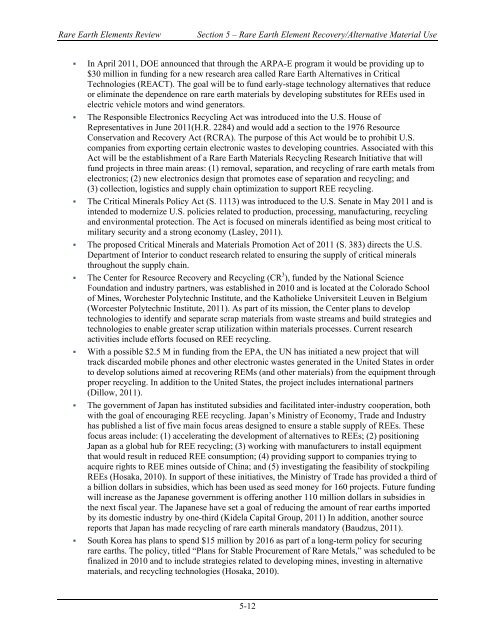Rare Earth Elements: A Review of Production, Processing ...
Rare Earth Elements: A Review of Production, Processing ...
Rare Earth Elements: A Review of Production, Processing ...
You also want an ePaper? Increase the reach of your titles
YUMPU automatically turns print PDFs into web optimized ePapers that Google loves.
<strong>Rare</strong> <strong>Earth</strong> <strong>Elements</strong> <strong>Review</strong> Section 5 – <strong>Rare</strong> <strong>Earth</strong> Element Recovery/Alternative Material Use<br />
� In April 2011, DOE announced that through the ARPA-E program it would be providing up to<br />
$30 million in funding for a new research area called <strong>Rare</strong> <strong>Earth</strong> Alternatives in Critical<br />
Technologies (REACT). The goal will be to fund early-stage technology alternatives that reduce<br />
or eliminate the dependence on rare earth materials by developing substitutes for REEs used in<br />
electric vehicle motors and wind generators.<br />
� The Responsible Electronics Recycling Act was introduced into the U.S. House <strong>of</strong><br />
Representatives in June 2011(H.R. 2284) and would add a section to the 1976 Resource<br />
Conservation and Recovery Act (RCRA). The purpose <strong>of</strong> this Act would be to prohibit U.S.<br />
companies from exporting certain electronic wastes to developing countries. Associated with this<br />
Act will be the establishment <strong>of</strong> a <strong>Rare</strong> <strong>Earth</strong> Materials Recycling Research Initiative that will<br />
fund projects in three main areas: (1) removal, separation, and recycling <strong>of</strong> rare earth metals from<br />
electronics; (2) new electronics design that promotes ease <strong>of</strong> separation and recycling; and<br />
(3) collection, logistics and supply chain optimization to support REE recycling.<br />
� The Critical Minerals Policy Act (S. 1113) was introduced to the U.S. Senate in May 2011 and is<br />
intended to modernize U.S. policies related to production, processing, manufacturing, recycling<br />
and environmental protection. The Act is focused on minerals identified as being most critical to<br />
military security and a strong economy (Lasley, 2011).<br />
� The proposed Critical Minerals and Materials Promotion Act <strong>of</strong> 2011 (S. 383) directs the U.S.<br />
Department <strong>of</strong> Interior to conduct research related to ensuring the supply <strong>of</strong> critical minerals<br />
throughout the supply chain.<br />
� The Center for Resource Recovery and Recycling (CR 3 ), funded by the National Science<br />
Foundation and industry partners, was established in 2010 and is located at the Colorado School<br />
<strong>of</strong> Mines, Worchester Polytechnic Institute, and the Katholieke Universiteit Leuven in Belgium<br />
(Worcester Polytechnic Institute, 2011). As part <strong>of</strong> its mission, the Center plans to develop<br />
technologies to identify and separate scrap materials from waste streams and build strategies and<br />
technologies to enable greater scrap utilization within materials processes. Current research<br />
activities include efforts focused on REE recycling.<br />
� With a possible $2.5 M in funding from the EPA, the UN has initiated a new project that will<br />
track discarded mobile phones and other electronic wastes generated in the United States in order<br />
to develop solutions aimed at recovering REMs (and other materials) from the equipment through<br />
proper recycling. In addition to the United States, the project includes international partners<br />
(Dillow, 2011).<br />
� The government <strong>of</strong> Japan has instituted subsidies and facilitated inter-industry cooperation, both<br />
with the goal <strong>of</strong> encouraging REE recycling. Japan’s Ministry <strong>of</strong> Economy, Trade and Industry<br />
has published a list <strong>of</strong> five main focus areas designed to ensure a stable supply <strong>of</strong> REEs. These<br />
focus areas include: (1) accelerating the development <strong>of</strong> alternatives to REEs; (2) positioning<br />
Japan as a global hub for REE recycling; (3) working with manufacturers to install equipment<br />
that would result in reduced REE consumption; (4) providing support to companies trying to<br />
acquire rights to REE mines outside <strong>of</strong> China; and (5) investigating the feasibility <strong>of</strong> stockpiling<br />
REEs (Hosaka, 2010). In support <strong>of</strong> these initiatives, the Ministry <strong>of</strong> Trade has provided a third <strong>of</strong><br />
a billion dollars in subsidies, which has been used as seed money for 160 projects. Future funding<br />
will increase as the Japanese government is <strong>of</strong>fering another 110 million dollars in subsidies in<br />
the next fiscal year. The Japanese have set a goal <strong>of</strong> reducing the amount <strong>of</strong> rear earths imported<br />
by its domestic industry by one-third (Kidela Capital Group, 2011) In addition, another source<br />
reports that Japan has made recycling <strong>of</strong> rare earth minerals mandatory (Baudzus, 2011).<br />
� South Korea has plans to spend $15 million by 2016 as part <strong>of</strong> a long-term policy for securing<br />
rare earths. The policy, titled “Plans for Stable Procurement <strong>of</strong> <strong>Rare</strong> Metals,” was scheduled to be<br />
finalized in 2010 and to include strategies related to developing mines, investing in alternative<br />
materials, and recycling technologies (Hosaka, 2010).<br />
5-12















